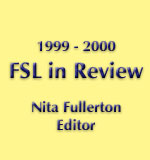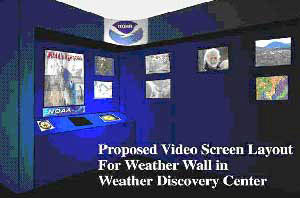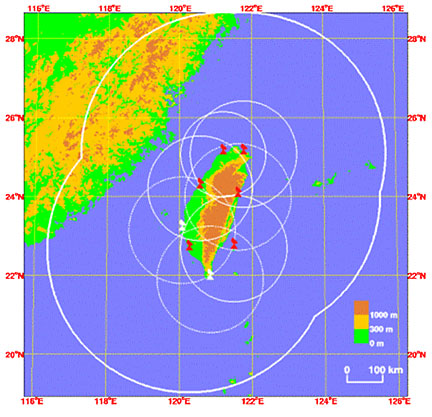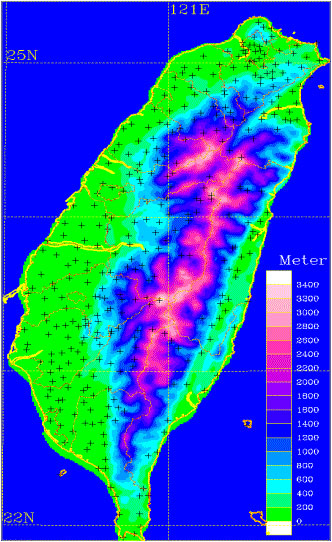|
|


Introduction
International
|
|

Objectives The International Division's mission is to oversee internal development of systems intended primarily for global or international application and to facilitate international cooperative agreements and technology transfer programs. Support is provided for four major activities:
The GLOBE Program The Global Learning and Observations to Benefit the Environment (GLOBE) Program is an international environmental research program that links the efforts of students, teachers, and scientists. Students at schools around the world monitor a wide variety of environmental parameters that are regularly posted on the GLOBE Website. This provides a unique global database of atmospheric, soil, biologic, and hydrologic measurements available to researchers for a multitude of experiments. Since the GLOBE Program was initiated in 1995, it has grown to more than 8,000 participating GLOBE schools located in 89 partner countries (Figure 56). Staff in the International Division are responsible for the development and maintenance of the main GLOBE Web server, the real-time data acquisition, and the central GLOBE database.
The Joint Forecast Systems Project at the Taiwan Central Weather Bureau The longest standing cooperative project is the Joint Forecast Systems Project (JFSP) in the Central Weather Bureau (CWB) of Taiwan. The JFSP is a model for many other international technology transfer efforts within FSL and other NOAA organizations. The cooperative emphasis of the project is apparent in the productive role of visiting scientists who become well versed in the project details while contributing valuable expertise to the ongoing technical development. The FSL-CWB partnership began in 1988 with an exchange of visits between key members of the two organizations. The relationship quickly grew through a CWB proposal for an FSL-designed forecaster workstation in 1989 and an agreement for technical cooperation in meteorology development in 1990. A broad project implementation plan was developed in 1990, followed by a cooperative agreement signed by both parties in June 1990 that included a proposal to develop a nowcasting system for CWB. Since then, the partnership has grown to include major initiatives for improving CWB forecasting capabilities. The current Phase III of the project (1996–2001) has demonstrated tremendous growth in CWB forecasting capabilities. These joint activities have created significant mutual benefits, especially in four primary areas of cooperation: information systems, data assimilation and modeling, high-performance computing, and observing systems. The effectiveness of the CWB-FSL cooperation is based in large part on CWB’s willingness and ability to develop and use customized products with associated technical support. FSL’s mandate to provide useful technologies fits with CWB’s real-world forecasting needs. With more than ten years of experience working together, the partnership is mature, efficient, and effective. CWB now enjoys the benefits of the strong forecasting infrastructure built during prior phases of the CWB-FSL cooperation. Greater data collection and management capabilities, improved observation systems, and high-performance computing combine to empower CWB in generating new and more useful forecast products. CWB is positioned to take advantage of this infrastructure in new ways, with more powerful techniques being developed not only within FSL but in other NOAA laboratories as well. The FX-Net Project The FX-Net project was established to develop a network-based meteorological workstation. It will provide access to the interactive functionality of the FSL-developed WFO-Advanced workstation, selected as the AWIPS prototype. FX-Net is designed as an inexpensive, simple forecast workstation system for use in a variety of forecast, training, education, and research applications not requiring the full capabilities of a WFO-Advanced type system. Although designed primarily for Internet use, FX-Net also will accommodate local network, dial-up, and dedicated line use. It will have the look and feel of the WFO-Advanced workstation (Figure 57), but with resolution and complexity reduced somewhat to allow for rapid Internet response and for use with less expensive user workstations. Since it is being developed as a Java application, it can utilize a wide variety of user platforms. The present system requirement is a minimum configuration of a 400- megahertz procecessor with 128-megabytes memory.
The Mount Washington Observatory Project The objective of the Mount Washington Project is to couple atmospheric research activities with educational outreach targeted at the general public and students across the country. This project is based on a cooperative agreement between FSL and the Mount Washington Organization (MWO), recipient of a NOAA grant to demonstrate innovative educational approaches using weather to link the disciplines of science, math, geography, and history for visitors and schools nationwide. The Mount Washington region was chosen for this grant because it is home to some of the world's most extreme weather. The 6,288-feet high summit (Figure 58) lies in the path of the principal storm tracks and air mass routes that affect weather in the northeastern United States. As a region steeped in weather history, the Mount Washington observatory has regularly recorded observations and measurements since 1870. The summit-top observatory holds the world record for wind speeds measured by a surface station, 231 miles per hour in April 1934.
The education outreach program includes the Weather Discovery Center, located in North Conway, New Hampshire, and an interactive Website. The center offers an entertaining, interactive discovery experience to some of the 8.5 million annual visitors to the Mount Washington Valley. Visitors can learn from a series of multimedia presentations, interactive educational displays, and historical weather related exhibits from the New England area. Activities include a 10-minute introductory video, an interactive exhibit with a flow tank and an air cannon to experience how wind travels over surfaces and through space, and a replica of the old stage stop ("station"), complete with rime ice on the shingles and chains used to hold the building in place during high winds. The latter exhibit gives visitors a glimpse of how early meteorologists made their observations in the worst of conditions. Also, a live, interactive feed is available so that visitors at the center can discuss the weather with observers at the summit of Mount Washington. A highlight of the center is the NOAA "Weather Wall," an exhibit area of multiple interactive screens providing visitors an opportunity to learn more about the latest advances in weather forecasting (Figure 59). The exhibit features demonstrations of NOAA's Advanced Weather Interactive Processing System (AWIPS), the centerpiece of the modernized National Weather Service (NWS), and the FSL-developed Local Data Acquisition and Dissemination System (LDAD), an AWIPS component for disseminating critical weather information between the NWS field offices and state and local emergency preparedness agencies. Besides sharing its technology and overseeing progress of the development activities, FSL also assists in administering the NOAA grant for the Mount Washington Project.
Accomplishments The GLOBE Program With the GLOBE Program maturing, scientists are now reaping the benefits of the multitude of diverse measurements taken by students around the world. During 1999, for example, researchers used GLOBE data to pursue a variety of interests, including an experiment on how climate dynamics affected an important biosphere event – the blooming of buds. These "budburst" data, collected by 51 GLOBE schools in the Northern Hemisphere, included the dates when various plant species bloomed. Researchers at the University of Montana combined these data with satellite images to pinpoint the onset of “greenness" – a date that is highly variable from year to year. The actual date of greenness, or budburst, is affected by both short-term and long-term climate variability factors. According to an article in the January 2000 issue of Earth Observing Systems on this experiment, student data showed that dates of leaf budburst corresponded remarkably well with satellite growing season estimates. Figure 60 shows the GLOBE data entry page from the Lilac Investigation Website. In support of the GLOBE Program, an automated replication process was developed for the FSL GLOBE server, the German mirror server, and the NASA Goddard Space Flight Center (GSFC) visualization server. Collaboration on the logical database design continued with the GLOBE Program Office (in Washington, D.C.) and a database consultant from the National Institute of Standards and Technology (NIST). This work resulted in a large modification to the GLOBE database, enabling it to now handle the new GLOBE database model and include new GLOBE parameters. The most important system task involved the ongoing support of the new German GLOBE mirror server, which became operational in April 1998. This integrated Web server serves all available GLOBE Web pages from one site. FSL also supported the NASA/GSFC team with their development of an identical GLOBE mirror server. In addition, the GLOBE database was moved to a different hardware platform (from Hewlett Packard to Sun). The move of FSL to the David Skaggs Research Center required very detailed systems planning to minimize interruptions of operation.
As the GLOBE Program expands, new Web products continue to be developed. The products developed last year included new teacher administration pages, improved student interaction pages, upgrades to GLOBE Mail, displays of new GLOBE newsletters, a newly organized bulletin archive, and development of new site search engines. Work also continued on the implementation of additional Spanish and French pages. In addition to the above accomplishments, support for the education and science side of GLOBE included GLOBE teacher and trainer workshops, GLOBE school follow-up activities, and the development of new science protocols and data entry pages for newly selected GLOBE experiments. A considerable amount of time was spent checking the entire GLOBE database code and the GLOBE Website for Y2K compatibility. This was time well spent, since the GLOBE program had not a single glitch when the year 2000 began. The Joint Forecast Systems Project In meeting the goals of the Joint Forecast Systems Project to improve forecasting capabilities at the Central Weather Bureau in Taiwan, many major tasks were completed, including: Operational Use of the Scalable Modeling System (SMS) – In support of CWB’s newly installed supercomputer (Fujitsu VPP 7000) and related high-performance computer activities, FSL used the SMS tool to parallelize CWB’s typhoon model, the Typhoon Forecast System (TFS). FSL also completed SMS documentation, including a user guide, and provided user support. Development of an Internet-based Workstation – As mentioned earlier, the Internet-based forecast workstation FX-Net provides access to the interface functionality of the WFO-Advanced workstation via the Internet. FSL developed a client-server application for the CWB that provides network access to a modified WFO-Advanced workstation. The basic capabilities such as animation, toggle, and zoom, as well as network optimization of the system were also completed. CWB has begun customizing the FX-Net for its potential users: remote observation stations, schools, and other government organizations currently receiving CWB data and products. Local Analysis and Prediction System (LAPS) – FSL began work to establish the basic LAPS system at CWB, using CWB model data as background grid data and surface observation data to perform a four-dimensional data analysis. This task will also include necessary training, documentation, and technical support. The FX-Net Project Work continued on the client-server application under development at FSL that will provide network access to a modified WFO-Advanced workstation. The architecture of the system was constrained mainly by bandwidth limitations and the need to leverage existing workstation code. These issues were addressed through implementation of powerful data compression techniques along with multithreaded client-side processing and communication. Other important tasks include mirroring of the user interface, portability of the client Java code, and making necessary adaptations to the existing WFO-Advanced software. During the past year, the first operational version of FX-Net was completed. An initial version of this system was installed for evaluation by the Meteorology Department at Plymouth State College, New Hampshire. Professors there were able to test the system for use in a new teaching laboratory being built in support of the New England Climate Initiative. Additional development of FX-Net yielded a system that is successfully being used in the undergraduate curriculum at Plymouth State College (Figure 61). Compression of satellite imagery is one of the main strengths of FX-Net. Optimization of the compression algorithms remained a high priority over the past year. The performance of the quantization procedure was improved. Wavelet transforms can reconstruct an image in nearly full detail from a relatively small number of wavelet coefficients. The application of the wavelet compression to gridded model is being analyzed. A lot of time was dedicated to determining the requirements for many possible special applications of FX-Net, including use by remote data collection offices, fire weather groups, and university researchers. Analysis of these requirements is an ongoing effort, and some new features related to the requirements were prototyped, such as the AWIPS Product Maker. The Mount Washington Observatory Project The Weather Discovery Center, now 90% complete, includes over 20 interactive weather exhibits. FSL developers worked extensively with staff there to devise a method of bringing information available at the Discovery Weather Center to schools and science centers across the country via the Internet. FSL collaboration included creation of a Web-based program that offers examples of the information, technology, and exhibits at the NOAA Weather Wall. The NOAA AWIPS and LDAD systems were set up to demonstrate how forecasters detected and tracked the 3 May 1999 Tornado Outbreaks in Oklahoma. This exhibit also shows how meteorologists use remotely gathered data to render their weather predictions.
Completion of NOAA work last year at the center and implementation of the Web-based displays allows teachers and students to use these products to learn about the tools and applications used in weather forecasting that have been developed at FSL. The Website describes case study animations of weather events, shows examples of exhibits located in the center, and presents weather-related educational challenges for students to address. FSL staff were involved with the development of a traveling weather education outreach program. A representative of the center visits schools and science centers in the New England area with the "The Wonder of Weather" program, which reached more than 12,500 students and teachers in 70 separate settings last year. To complement the on-the-road outreach program a Web-based Internet site will offer teacher lesson plans, information about atmospheric science, and links to other weather education sites on the Web. Projections The GLOBE Program Development tasks will continue as the GLOBE Program evolves and grows. Fiscal Year 2000 will mark the initiation of the first GLOBE Web pages displaying Russian and Chinese languages. Two fully integrated GLOBE mirror servers will become operational in the United States, at NOAA/FSL and NASA/GSFC; once established, GLOBE data acquisition will be operational at three sites: FSL, GSFC, and Cologne, Germany. The database will be replicated among the three sites on an hourly basis. In addition, load balancing and minimizing of the distance between the user and the Web server will ensure much faster access times for users worldwide. Ongoing efforts will include development of new interactive Web pages and the design of new user interfaces to help maintain user interest in the GLOBE Program Website. The Joint Forecast Systems Project The next phase of the modernization of CWB meteorological services will be from 2002–2007. During Fiscal Year 2000, FSL will provide input for continuing (anticipated) support as well as for other areas of their scientific and technical expertise. The proposed JFSP cooperation will cover the following areas:
The FX-Net Project The next major task for the FX-Net project is to provide a weather forecasting tool for use at the 2002 Salt Lake City Olympics. FX-Net will be installed at a number of competition venues for use by an on-site forecaster. The first step is to install a test server at the National Weather Service Western Region headquarters for a test period to determine FX-Net requirements. Modifications and enhancements will be made to the system according to forecaster feedback regarding these requirements. An overall system installation and test will be completed during the winter of 2000. The International Division will work with the Salt Lake City Organizing Committee to provide an FX-Net workstation system for onsite forecasting at each outdoor site of the 2002 Winter Olympic Games. The system will be used for forecasting during the pre-Olympic events from December 2000 to March 2001 and in the Weather Support Systems Tests planned for January 2001. In support of the many other possible applications of FX-Net, development of more advanced features will continue. Examples of such features include the ability of a single FX-Net server to provide data for many AWIPS localizations, and optimization of data transmission in batch mode for fire weather use. As FX-Net servers are deployed outside of FSL, enhancements will be made to allow easy operational support of these systems. Studies will continue on the application of the wavelet compression to gridded model data. A very challenging task is the extension of the two-dimensional transform to three dimensions. Investigation will continue of the best way to apply new wavelet transform techniques to the data compression algorithm, in order to improve the compression ratio and retain the precision of the data.
The Mount Washington Observatory Project The Weather Discovery Center will be completely operational by May 2000, with expectations that a large percentage of visitors to the Mount Washington area will visit the center during the summer. Onsite interns will be available to guide visitors through the interactive weather exhibits in the center, making the visit more meaningful for everyone. The exhibit base at the center will continue to expand, with new exhibits becoming part of a "lending library" of displays to be shared with other centers across the country. An evaluation tool is being designed to solicit suggestions from visitors for consideration in designing new exhibits. FSL staff will continue to improve the Website. The Climate and Air Pollution Modeling Project FSL approved a project initiative to address climate and air pollution modeling issues. In close collaboration with other in-house NOAA laboratories, FSL will use its RUC model and the MM5/MCCM model to run real-time air pollution forecasts. Cooperation with the NOAA Aeronomy Laboratory and the Environmental Technology Laboratory concerning several air pollution modeling studies has already been established. Discussions are underway with the NOAA Climate Diagnostic Center concerning climate studies related to the southwestern United States. FSL will participate in the Houston 2000 field experiment that will focus on the high quantities of low-level ozone frequently detected in Houston during the summer. FSL will be using the data to run real-time air pollution forecasts. To prepare for this experiment, scientists in FSL's Forecast Research Division will run the two models (RUC2 and MCCM) with datasets from 1995 and 1999 for verification and validation purposes. The Cooperative Project with Korea Meteorological Administration FSL plans to establish a cooperative project with the Meteorological Research Institute (METRI) of the Korean Meteorological Administration (KMA). In this proposed five-year project, cooperative activities may be undertaken to help the KMA in any of the following areas:
|
|








